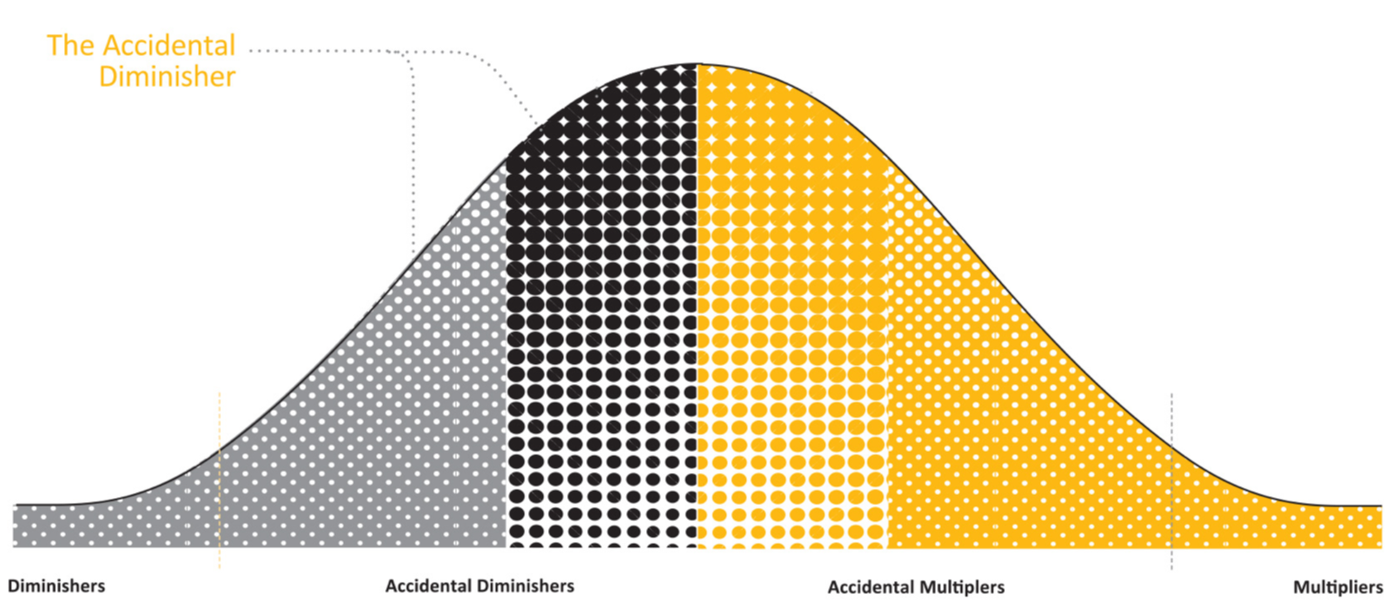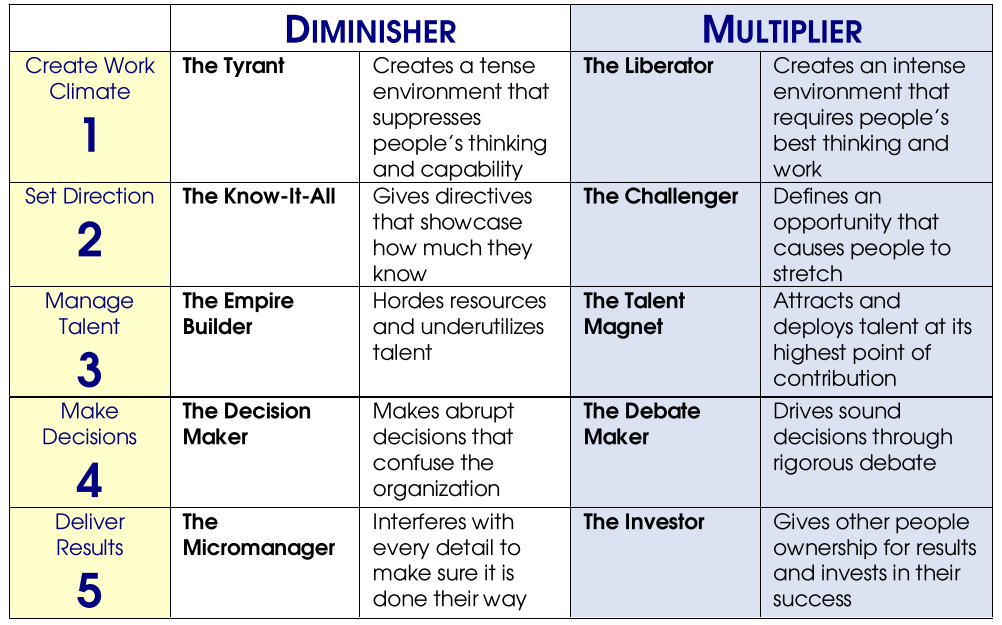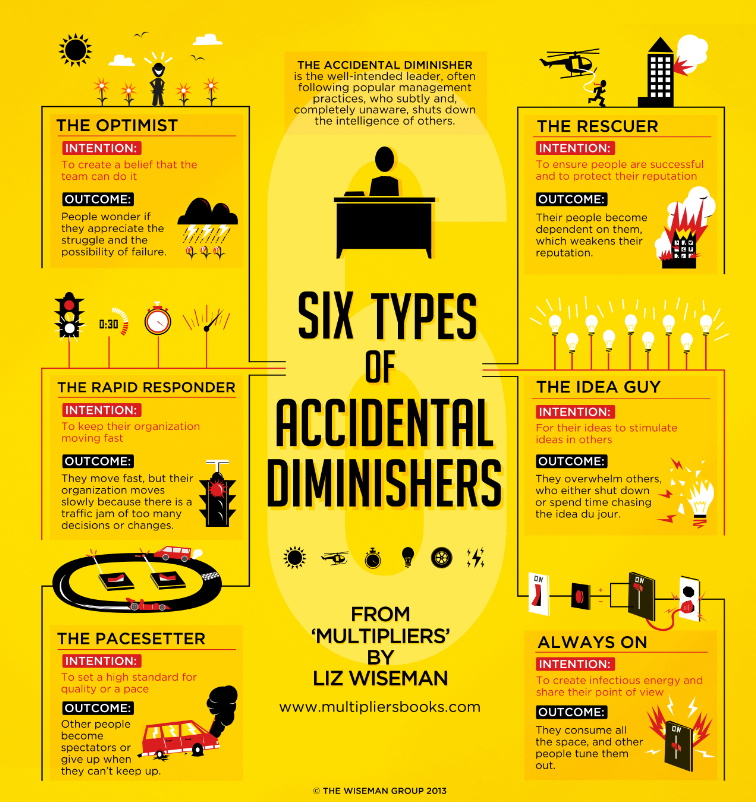
Liz Wiseman’s study of accidentally bad leaders
I was in a meeting in a different organisation recently and noted that the team in the room felt really low on energy, in fact the only one in the room that seemed energised was the person talking the most. I realised that this person was the ‘leader’ of the team and that it seemed that their personality was smothering the room, they were limiting debate, and only selecting one or two people to ask their opinions on their decisions (once they had already been made by them). This person was creating a team where they were the most important person, they believed they were the smartest and needed to fix all the problems and make all the decisions otherwise it wouldn’t be right.
On reflection, I realised what I was seeing was something that Liz Wiseman described in her book Multipliers where she describes multiplying leadership and diminishing leadership. Using the leadership framework she developed, the role of a leader has five distinct facets. These facets relate to; creating the right work climate, setting direction, managing their team’s talents, making appropriate decisions, and delivering results. In using this framework, she then delineated leadership along a continuum from a ‘Diminisher’ to ‘Multiplier’.
Reflecting on this book and her construct, I realised that the person leading that conversation, and perhaps unintentionally/or with their best intentions, were diminishing the abilities of their team. This may have been learnt from their mentors or role models, they may have seen success using these techniques before, or they may have really low trust in their teams in being able to do a good enough job. Either way, they were not getting the best out of their team.
So what separates a multiplier from a diminisher? Liz describes the types of accidental diminishing against each of those leadership categories in the below figure.

When I look over her list of archetypes and their attributes, I realise that I have tended to be a bit of a problem solver (which is accidental diminishing behaviour related to Micromanager), stepping in when I see things drifting of track or fixing other people’s problems for them. I try not to be, but tend to get frustrated that the team isn’t going to come up with an answer that fits what I think is needed. Then I realise that perhaps instead of fixing it, or correcting them, I need to give them some additional information and invest in them succeeding. This is something that I am working on improving. However, I also realise that I am getting better at getting the best out of people and challenging them to stretch.

We all have an opportunity to assess ourselves and look for opportunities to create multiplier environments, become multiplying leaders. If we do this, we get more engaged teams, producing better results and in a happier environment.
There are some links below to more information, including a YouTube video and a link to her webpage. On her webpage she has a heap of free resources, including a quiz to see if you are an accidental dimisher (by the way I think it sets out to make a point that we all have diminishing tendencies — good marketing ? — but still useful). She has also set a 30-day Multiplier challenge on the website that contains a heap of good information and a free chapter of her book that outlines how to deal with Diminsher’s (it’s good).
When I completed the quiz, Liz informed me about my tendencies through the quiz results, here is where I can improve;
- You see your role as protecting your employees from distraction and negative influences from people in the broader organisation (I answered to some extent), Liz says — You have a “Protector” tendency. You may be over-protecting your people and blocking them from the messy, complex problems that they need to learn to solve for themselves. You might be a comfortable leader to work for but too much like a Banyan tree, which provides shade and protection but under which nothing grows.
- You’re passionate, energetic, and articulate and can consume a lot of space in a meeting (I answered to a moderate extent), Liz says — You have an “Always On” tendency. You want to be engaged, present, and energetic, but you may be taking up too much space. You probably think your passion is infectious, but more likely it is stifling the thinking of others.
- You are a big thinker and lay out a compelling vision of the future that you evangelise to those around you (I answered to a moderate extent), Liz says — You have a “Strategist” tendency. Rather than inspiring your team, you might be providing too prescriptive of a vision to them. Vision casting is a popular leadership practice, but you may not be leaving enough space for others to think through the challenges for themselves and generate the intellectual muscle to make the organisation’s vision a reality.
- Your mind races with ideas and is a fountain of innovation. You come up with ideas for new strategies or products and are continually spouting new ideas for your team to toss around and play with (I answered to some extent), Liz says — You have an “Idea Guy” tendency. You may think you’re sparking creativity with non-stop ideas, but you are quite possibly causing organisational whiplash. As people dart around to keep up with each new idea, they end up making only making a millimetre of progress in a hundred directions.
- You react quickly when problems or opportunities surface by making rapid decisions that keep the organisation moving forward (I answered to a moderate extent), Liz says — You have a “Rapid Responder” tendency. By responding quickly to issues as they are raised, you may make decisions that make sense to you but leave your organisation reeling, debating how to execute on these decisions. But if you take the time to gather more data and hear from other voices, you will arrive at more sound decisions that can be executed more easily across the organisation.
- When you see people failing, you jump in to rescue them or the project in order to help them avert failure and get on the path of success (I answered to a moderate extent), Liz says — You have a “Rescuer” tendency. When you rescue struggling people, you can diminish their capability by weakening their ability to think for themselves and to learn how to spot problems and recover from them. Instead of creating a cycle of success, you may be creating chronic dependency on you as the leader and weakening their reputation.
- As the leader, you set the pace and the standard for delivering high-quality work. You make a point of working hard and delivering top notch results, so others can learn from your example (I answered to a moderate extent), Liz says — You have a “Pacesetter” tendency, the most common AD tendency among leaders we’ve surveyed. You believe your hard work and top notch results will rub off on your team and creates a work ethic and high standard for your entire organisation. However, it is possible that your pace-setting is actually reducing accountability levels inside your organisation as others assume that you will perform Herculean acts so they don’t have to.
- You are a “can-do” manager who sees possibilities and believes that most problems can be tackled with hard work and the right mindset (I answered to a great extent), Liz says — You have an “Optimist” tendency, which means you could be undervaluing the struggle the team is experiencing and the hard-fought learning and work. Or, worse, you might be sending an unintentional message that mistakes and failure are not an option. When the leader sees only the upside, others can become preoccupied with the downside.
- You appreciate excellence and exactness, so you offer helpful critiques and point out mistakes to help people improve their work (I answered to some extent), Liz says — You have a “Perfectionist” tendency. While you are offering suggestions for improvement you can envision a masterpiece in the making, but others see nothing but criticism of their work. They may feel like their work is “never good enough” and can easily become disengaged and disheartened. Sometimes a 90 percent solution executed with 100 percent ownership is better than getting it 100 percent right with a disengaged team. [I wrote about this a bit here].
There were some questions that I did not have diminishing tendencies, but I found the quiz very useful. Because of this additional awareness I have put additional effort into reducing these tendencies. In the end, it highlights that there is always areas for improvement in leading a team.
Liz likes to conclude with a quote from Bono (U2 fame) regarding meeting with the British Prime Minister;
“It has been said that after meeting with the great British Prime Minister William Ewart Gladstone, you left feeling he was the smartest person I the world, but after meeting with his rival Benjamin Disraeli, you left thinking you were the smartest person in the world.”
This sums up the effect of Multiplier leadership, help your team reach levels beyond what even they imagined by multiplying across these five facets. We should work at creating smart people wherever we go, to do this we need to challenge them and give them space to try things and work out what works.
Stay safe and keep smiling
Leon
[high-five]

Found your article interesting to read. I can not wait to see your article.
Good Luck for your upcomingupdate. Thiss article is truly very interesting and effective.
Best regards,
Harrell Zacho
Great article. Couldn’t be write much better!
King regards,
Dinesen Hessellund
Thank you for sharing your thoughts. I really appreciate your efforts and I will be waiting for your further post thanks once again.